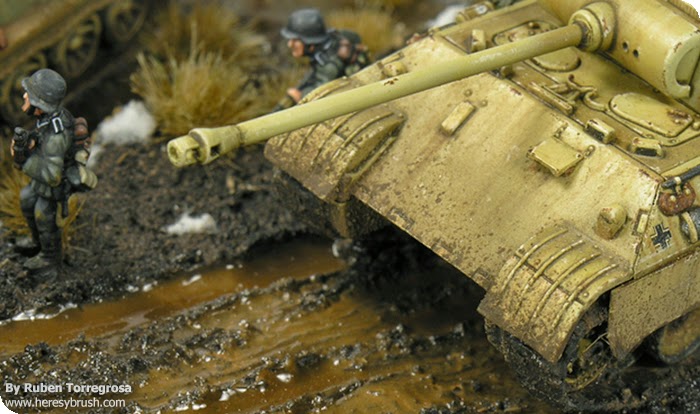We have spoken several times about how to do mud on the undercarriage, using pigments or pastels like tool. In this occasion, I propose you other simple way to use them, with one additional idea: simulate a granulated texture. To explain this process, I have used a 15mm (1/100 scale) miniature from The Plastic Solider.
As I told before, the main tool will be the pigments. Nowadays, we can find a really enormous amount of pigment colors on the market. Thus, I have an important collection of pigments in my hands, so I can get any color I want. I’m talking about this, because I think it is so much interesting to use a mix of colors than to use just only one. For example, in this occasion I have mixed three different pigments to get one intermediate earth color, but with different tones. Maybe you could think that this mixture is a little useless, but we will get an important chromatic variety, and so, our model will be more attractive. This pigment mixture is so easy to prepare. You only need drop a little of each pigment in a jar, and then stir it with a brush or spatula. Be careful with the colors used. If we want simulate the Kursk earth, we can’t use colors too light.

Once the mixture is ready, we sprinkle it in our area of interest using a brush or spatula. It is not necessary applies much pigment, because the idea is to use this initial layer like a base when we apply the Pigment Fixer. This base will prevent that liquid run off everywhere.

Thus, next step will be use the Pigment Fixer to stick our pigments. Because we have an initial layer with pigments, we have to be careful when we apply the PF to avoid drag it. We charge the brush with the Fixer and then we gently deposit one drop on pigments. As soon as the drop touches the pigment, it will spread fastly. Probably we will have to repeat the process to wet the whole pigment layer. However, we must not puddle. We just want to moisten it.

Finally, before the Pigment Fixer get dry, we sprinkle more pigment on the area. When the pigment gets in touch with the Fixer, it will absorb it fastly. The idea is add pigment until the Fixer is saturated. I.e., we add pigment until we see there are no more Fixer to absorb, and the pigment has got a granulate texture. It is better have more pigment which we need than not have enough. If we don’t add enough pigment, the Fixer is going to dissolve it and probably we won’t get a good texture.

Note, when the pigment is wet the color is so dark. But when the Fixer is dry, the pigment color is similar to original. So, don’t be scared of that!. Also, in these paragraphs I’ve been talking about how simulate dry mud. However, if you want to simulate wet mud, you can apply differential washes with AK 023 Dark Mud or other enamels. Differential washes suppose to use different dilutions, so we can get different grades of humid. Anyway, you can apply these enamels to make streaking effects, and represent fresh mud streaks.
On the other hand, if you are interested in other ways of how to make mud, both in vehicles, soldiers and scenes, I recommend you last issue of The Weathering Magazine (AK-Interactive) about MUD. Indeed, I have the pleasure of having published an article in this issue, with a Panthers diorama in Russia and in 1/100 scale. Because this opportunity I am very grateful!!!. In my article, destined to Flames of War miniatures, you could see how to make mud on vehicles splashes or how to make mud puddles, among others things. In the other articles you will find all techniques and tools used nowadays to simulate any kind and effect of mud. Because the mud is one of the most interesting effects in our models, I recommend this magazine ;).

